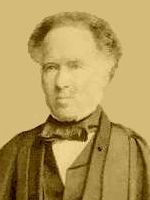James Challis facts for kids
Quick facts for kids
James Challis
|
|
|---|---|
 |
|
| Born | 12 December 1803 Braintree, Essex, England
|
| Died | 3 December 1882 (aged 78) Cambridge, England
|
| Known for | Not discovering Neptune |
| Scientific career | |
| Fields | Astronomy |
| Institutions | Cambridge Observatory |
James Challis (born December 12, 1803 – died December 3, 1882) was an English clergyman, physicist, and astronomer. He was a professor of astronomy and the head of the Cambridge Observatory. He studied many different science topics, but he is mostly remembered for a big missed chance. In 1846, he almost discovered the planet Neptune.
Contents
Early Life and Education
James Challis was born in Braintree, Essex, England. His father, John Challis, worked as a stonemason. James went to local schools and then studied at Trinity College, Cambridge. He finished his studies in 1825 as a top student.
In 1826, he became a fellow at Trinity College. He was ordained as a clergyman in 1830. He worked for the college until 1852. In 1831, Challis married Sarah Copsey. They had a son and a daughter.
Professor of Astronomy
In 1836, James Challis became the director of the Cambridge Observatory. He also became the Plumian Professor of Astronomy. He taught many different areas of physics.
As an examiner, he looked at the early work of many famous scientists. These included G. G. Stokes, Arthur Cayley, John Couch Adams, William Thomson (who later became Lord Kelvin), Peter Guthrie Tait, and James Clerk Maxwell. Challis often disagreed with Stokes's ideas in his research.
Challis also helped Thomson and Maxwell get jobs at universities. He and Thomson worked together to set a topic for a science prize. The topic was about the rings of Saturn. James Clerk Maxwell won this prize in 1857.
Work at Cambridge Observatory
Challis took over the Cambridge Observatory from George Biddell Airy. He worked hard to make the instruments better and the observations more accurate.
He was one of the first to see a comet called 3D/Biela break into two pieces in 1846. He saw both pieces again in 1852. Challis published over 60 scientific papers about his observations of comets and asteroids. He also invented two tools: the meteoroscope in 1848 and the transit-reducer in 1849. He published twelve books of his observations from the Cambridge Observatory.
Challis and his wife lived at the observatory for 25 years. He eventually left his job at the observatory. He found it hard to keep up with all the new astronomical observations. His successor was John Couch Adams, but Challis remained a professor until he died.
The Search for Neptune
In 1846, George Biddell Airy finally convinced Challis to help search for a new planet. This planet was thought to be the eighth planet in our Solar System. John Couch Adams had predicted where this planet might be as early as 1844. He based his prediction on how the orbit of Uranus was acting strangely.
Challis started his search in July 1846. He didn't know that a French astronomer, Urbain Le Verrier, had made the same prediction. A German astronomer named Johann Gottfried Galle, with help from Heinrich Louis d'Arrest, found the planet on September 23. The planet was named "Neptune".
Later, people looked at Challis's notebooks. They found that he had actually seen Neptune twice, a month before Galle. But he didn't realize it was the new planet. He blamed this on being too busy with other work at the observatory. He wrote in a letter:
I was very sad to find that my observations would have shown me the planet in early August if I had only looked at them closely. ... I put off doing this ... mainly because I was trying hard to finish many comet observations, and this took all my time.
Ideas as a Physicist
Challis also studied how liquids move and how light works. He believed in the wave theory of light. He also thought there was a special substance called a luminiferous ether that light traveled through.
He had some unique ideas about how everything in the universe worked. He tried to explain all physical things using a model of tiny spherical atoms moving in this fluid ether. He even tried to explain gravity with his ideas. However, not many scientists agreed with his theories.
Religious Views
Challis also wrote about his religious views. He discussed how the Book of Genesis from the Bible could be understood. He believed that the biblical story of creation could fit with what geology (the study of Earth's history) showed.
Legacy and Recognition
Challis published 225 papers on mathematics, physics, and astronomy. He was re-elected as a fellow of Trinity College in 1870. He passed away in Cambridge and was buried next to his wife.
Even with the mistake about Neptune, Challis did make real contributions to astronomy. His way of mixing religion and science was similar to other scientists of his time. However, his specific theories about physics and religion did not have a lasting impact.
A Lunar crater on the Moon is named Challis in his honor.
Honours and Memorials
- Fellow of the Royal Astronomical Society, (1836)
- Fellow of the Royal Society, (1848)
- Bronze medal at The Great Exhibition for his transit-reducer, (1851)
See also
 In Spanish: James Challis para niños
In Spanish: James Challis para niños

